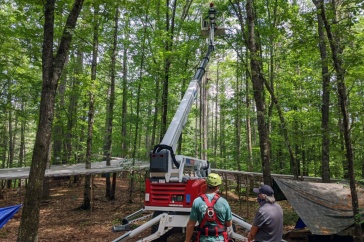UNH Scientist Finds 2020 Severe Drought Likely to Slow Tree Growth Next Year

UNH researchers are using a “throughfall” structure to conduct drought experiments.
DURHAM, N.H.—Red oak and white pine trees could experience slower growth next year as a result of the severe drought in New Hampshire and most of New England that began in mid-August, according to a researcher with the New Hampshire Agricultural Experiment Station at the University of New Hampshire.
Heidi Asbjornsen, associate professor of natural resources and the environment, said the results of previous drought experiments foretell that red oaks could experience a slower recovery from the drought next year compared to white pines, although growth for both species is likely to lag. This can result in reduced overall growth during 2021, particularly for red oaks and may make them more susceptible to pathogens and disease.
According to the N.H. Division of Forests and Lands, New Hampshire is 81% forested, accounting for 4.8 million acres. The forest’s direct impact on the economy of the state is $2.26 billion annually, approximately half related to forest-based manufacturing and half to recreation and tourism.
According to the U.S. Drought Monitor, southeast New Hampshire was in a severe drought from Aug. 18 to Sept. 8. Most of the rest of the state was in a moderate drought during the same period. On Sept. 15, the southwest portion of the state moved into an extreme drought, with the rest of New Hampshire in a severe drought. The 2020 drought is similar to the one the state experienced in 2016: occurring later in the season and affecting the southeast portion of the state to the greatest extent. The 2016 drought was the 11th driest summer that New Hampshire had experienced since 1895, and the driest since 1993.
“Both red oak and white pine are having a mast year—producing a prolific amount of seed, which happens only sporadically,” said Asbjornsen. “Red oak also experienced a mast year in 2019. This may increase the trees' risk for depletion of carbohydrate reserves. These reserves are important for providing energy to the tree during stressful periods, such as droughts, as well as for producing defense compounds and other responses that reduce risk from pathogens and pests.”
White pine and red oak have very different ecological “strategies” for managing moisture stress that occurs during a drought. White pines tend to be relatively conservative, shutting down water uptake and photosynthesis as moisture becomes more limiting. In contrast, red oak is considered a more drought tolerant species due to its deep roots, ring-porous wood, and a less conservative water use strategy that allow it to continue photosynthesizing even as moisture becomes more limiting.
“Our experimental drought research will continue over the next several years to better understand the differing sensitivities of these two important northeastern tree species to extreme drought, as well as the implications for the health and productivity of mixed pine-oak forests,” she said. “Because this drought is occurring late in the growing season, the trees already have completed much of their growth for this year. Thus, we would expect the overall effects of the drought on tree health and growth this year to be relatively low.”
Regarding other species, the most notable observation researchers saw during the 2020 drought was that some birches dropped a large number of leaves in August when it was both dry and hot. This is a strategy to reduce the impacts of moisture stress. Without leaves, they will lose less water and protect their tissues from damage. However, since they lost their leaves relatively early in the growing season, this also may put them at greater risk for negative health impacts or even mortality in the future.
This material is based upon work supported by the NH Agricultural Experiment Station, through joint funding of the National Institute of Food and Agriculture, U.S. Department of Agriculture, under award number 1013351, and the state of New Hampshire.
Founded in 1887, the NH Agricultural Experiment Station at the UNH College of Life Sciences and Agriculture is UNH’s first research center and an elemental component of New Hampshire's land-grant university heritage and mission.
PHOTOS AVAILABLE FOR DOWNLOAD
https://colsa.unh.edu/nhaes/sites/default/files/media/images/drought.jpg
NHAES researchers sample a tree canopy in fall of 2020 as part of their drought research.
Courtesy photo
https://colsa.unh.edu/nhaes/sites/default/files/media/images/drought2.jpg
UNH researchers are using a “throughfall” structure to conduct drought experiments.
Courtesy photo
Latest News
-
June 18, 2024
-
June 18, 2024
-
May 17, 2024
-
May 14, 2024
-
May 7, 2024

















































